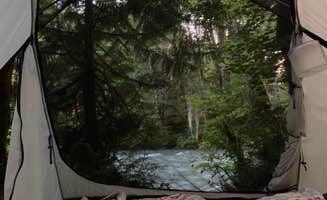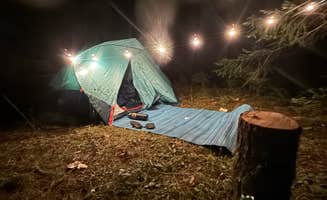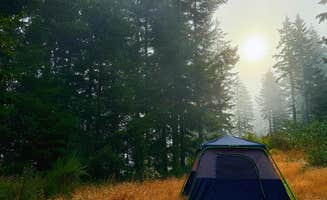Dispersed camping near Walterville, Oregon offers backcountry access on multiple USFS and BLM roads throughout the Willamette National Forest. The area sits at elevations ranging from 700 to 4,000 feet with steep terrain characterized by mixed conifer forests and fast-flowing creeks. Many primitive camping spots remain accessible year-round, though winter conditions can make forest roads challenging without proper vehicles.
What to do
Kayaking on still waters: Hult Pond provides calm waters ideal for paddling with no motorized boats allowed. A visitor noted, "The pond was great for kayaking and there is plenty to explore if you aren't worried about a little elevation in your hike." The pond features standing logs that create interesting obstacles and wildlife viewing opportunities.
Wildlife watching: Doolittle Butte offers excellent stargazing and wildlife viewing from its elevated position. "Beautiful views of stars on a clear night. Very remote. Climb an easy dirt road back a few miles. A few deep potholes but nothing too technical," reports one camper. Morning hours provide the best opportunity to spot deer, elk and numerous bird species.
Gold panning: Try your luck in Quartzville Creek where recreational mining is permitted. "A little bit of luck head to the stream and find some gold," suggests a visitor. Bring basic equipment like a small pan and shovel. Best spots are along lower elevation areas where the current slows.
What campers like
Solitude in remote areas: Saddle Camp provides true wilderness isolation for those willing to navigate the access roads. "It is a very fun drive though taxing and it is slow going. But was out there it is complete quiet and solitude," shares one camper. Most visitors report seeing fewer than five other groups even during summer weekends.
River access: Multiple pull-offs along forest roads provide direct water access. "If you drive past all the campsites and go over the bridge take a right, there are so many spots available on that road and all have their own access to the river," writes one camper about Blue River Reservoir areas. Most riverside spots have natural paths leading to swimming holes.
Privacy between sites: BLM Kentucky Falls Road camping areas offer good separation between pull-offs. "Great spot! Quiet and if you walk a little over through a trail you'll get an amazing view of the sunset," notes a visitor. Most sites are spaced at least 100 yards apart providing natural buffers of trees and shrubs.
What you should know
Cell coverage gaps: Many rustic camping sites near Walterville have zero connectivity. "We lost cell service about an hour before we even got there, and didn't have any the whole time there," reports a Hult Pond visitor. Reliable signal returns only when approaching Highway 126 or larger towns.
Fire regulations vary seasonally: Restrictions become increasingly common from July through October. "No fires allowed due to recent fires in the area," notes one camper. Always check current rules with the local ranger district before your trip as violations carry substantial fines.
Limited facilities: Salt Creek Backwoods typifies the minimal infrastructure at most sites. "This spot was actually an accidental find but worked out great because we were not able to turn around on the tight road we found ourselves on. It opened up tremendously and gave us great grounds to camp on for a few nights," explains a camper. Plan to pack out all waste and bring all water needed.
Tips for camping with families
Scout accessible water spots: Look for gentler creek access points for kids. "We stayed at almost every spot there just to check out the different areas of the river," shares one Blue River camper. Areas with gradual entry points and slower currents work best for younger children.
Pack extra garbage bags: Many campers report finding trash at popular sites. "I did walk around our area and pick up a bunch of trash left by others," notes a Hult Pond visitor. Teaching kids to participate in site cleanup creates valuable stewardship lessons.
Plan for no-tech entertainment: Forest Road 5875 and similar areas offer complete digital disconnection. "Got into Eugene super late and started the drive down to Crater lake. Wife and I decided the safe thing was to post up for the night and continue on in the morning," writes one camper about this convenient stop. Bring physical games, wildlife identification guides and star charts for evening activities.
Tips from RVers
Scout turnaround points: Forest roads often lack designated places to turn larger vehicles. "Kind of no turn around options and driving forward was all our only choice at that point…to be honest the drive made me nervous. It was a tight dirt road but once we found a spot it was cleared pretty good," explains an RV camper at Salt Creek Backwoods.
Look for quarry road access: Several camping areas use former or active logging roads with more substantial width and grading. "Beautiful recreation area... mostly roadside limited facilities and or services but beautiful area... windy narrow road a couple state campgrounds and day use areas... limited places to turn around," notes an RVer who visited Quartzville Recreation Corridor.
Arrive early for level spots: The most suitable RV parking areas fill quickly during peak season. "Only a few good spots and they go fast so definitely get there early to get a good spot," advises a Hult Pond visitor. Weekday arrivals before 2pm typically offer the best selection.






